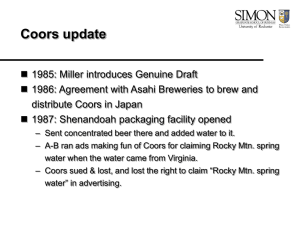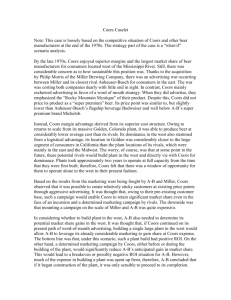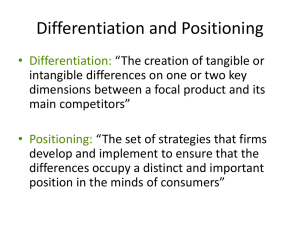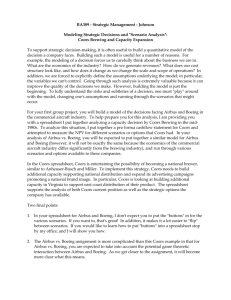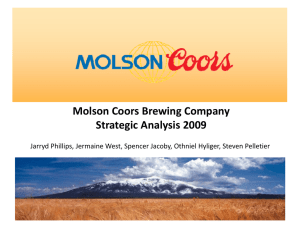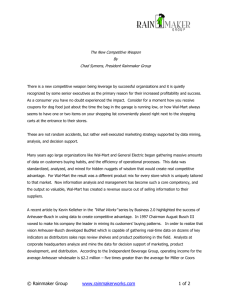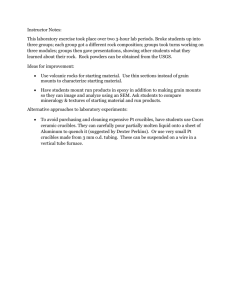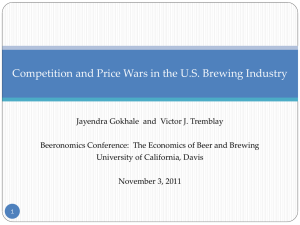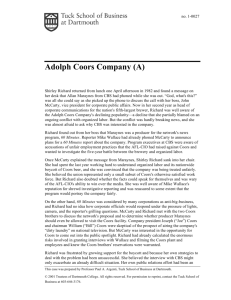Case Study: Coors Beer and AFL
advertisement
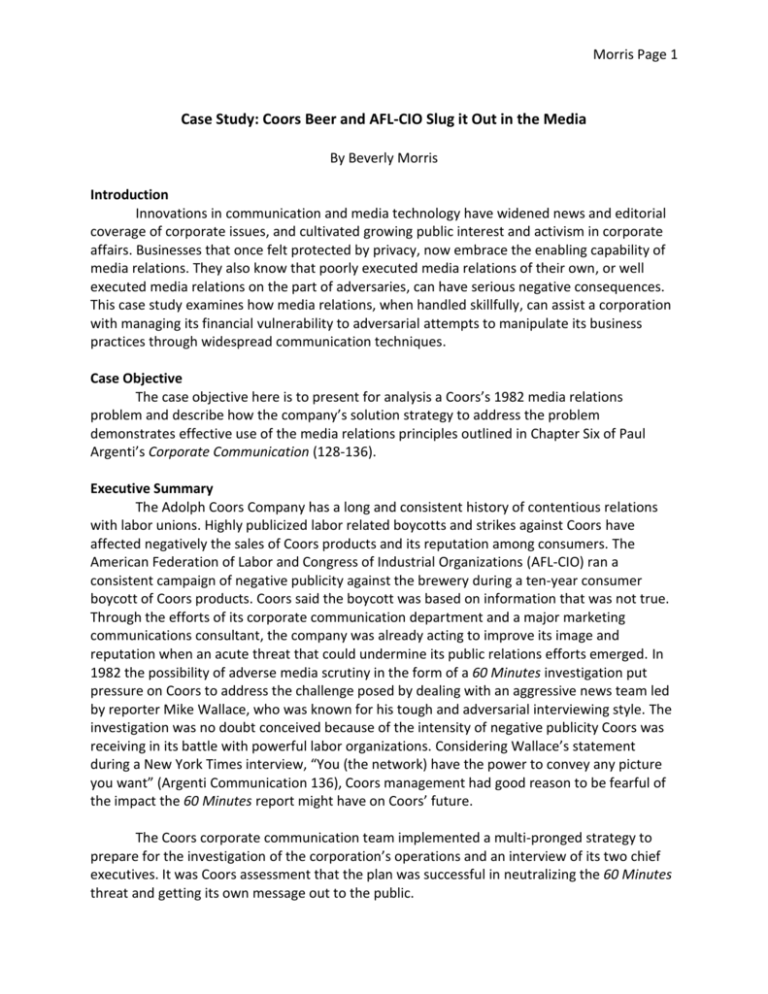
Morris Page 1 Case Study: Coors Beer and AFL-CIO Slug it Out in the Media By Beverly Morris Introduction Innovations in communication and media technology have widened news and editorial coverage of corporate issues, and cultivated growing public interest and activism in corporate affairs. Businesses that once felt protected by privacy, now embrace the enabling capability of media relations. They also know that poorly executed media relations of their own, or well executed media relations on the part of adversaries, can have serious negative consequences. This case study examines how media relations, when handled skillfully, can assist a corporation with managing its financial vulnerability to adversarial attempts to manipulate its business practices through widespread communication techniques. Case Objective The case objective here is to present for analysis a Coors’s 1982 media relations problem and describe how the company’s solution strategy to address the problem demonstrates effective use of the media relations principles outlined in Chapter Six of Paul Argenti’s Corporate Communication (128-136). Executive Summary The Adolph Coors Company has a long and consistent history of contentious relations with labor unions. Highly publicized labor related boycotts and strikes against Coors have affected negatively the sales of Coors products and its reputation among consumers. The American Federation of Labor and Congress of Industrial Organizations (AFL-CIO) ran a consistent campaign of negative publicity against the brewery during a ten-year consumer boycott of Coors products. Coors said the boycott was based on information that was not true. Through the efforts of its corporate communication department and a major marketing communications consultant, the company was already acting to improve its image and reputation when an acute threat that could undermine its public relations efforts emerged. In 1982 the possibility of adverse media scrutiny in the form of a 60 Minutes investigation put pressure on Coors to address the challenge posed by dealing with an aggressive news team led by reporter Mike Wallace, who was known for his tough and adversarial interviewing style. The investigation was no doubt conceived because of the intensity of negative publicity Coors was receiving in its battle with powerful labor organizations. Considering Wallace’s statement during a New York Times interview, “You (the network) have the power to convey any picture you want” (Argenti Communication 136), Coors management had good reason to be fearful of the impact the 60 Minutes report might have on Coors’ future. The Coors corporate communication team implemented a multi-pronged strategy to prepare for the investigation of the corporation’s operations and an interview of its two chief executives. It was Coors assessment that the plan was successful in neutralizing the 60 Minutes threat and getting its own message out to the public. Morris Page 2 Background The Coors brewery was established in Golden, Colorado, in 1880 by Adolph Coors, who emigrated from Prussia, bringing his beer brewing expertise with him. The company remained under family ownership and management until going public in 1975. When Prohibition outlawed the brewing of alcoholic beverages for 17 years, Coors continued to operate by producing malted milk and developing new operations— manufacturing cement and porcelain products. With the end of Prohibition in 1933, Coors resumed brewing beer and created subsidiary companies that formed Coors fully owned “vertically integrated” business that consolidated key production and distribution components—bottling, container manufacturing, transportation, energy, and recycling (Argenti, Communication 129). Coors beer became known for its quality and the mystique surrounding the family owned tradition of the company and its brewing method contributed to the beer achieving cult status and celebrity recognition. Coors beer sold well in its 12-state, western U.S. market (Argenti, Communication 130). Labor relations troubles Coors became unionized in 1914 and has had a consistently adversarial relationship with labor unions since 1920, when Prohibition forced the beer brewing company to reduce its labor force. Coors had offered to retain older employees to work in its alternative operations, and it let younger workers go. The union reacted with a protracted strike that ended when Prohibition was repealed in 1933. Other strikes ensued. In 1953—management capitulated immediately; 1955 saw workers at Coors’ porcelain company return to work on the company’s terms after 117 days; in 1957 a four-month strike, during which Coors used non-union workers and threatened to hire them permanently, ended with the strikers’ capitulation. Other unions representing workers at Coors (electricians, building and construction workers) would strike unsuccessfully, and “[b]y 1970, the Coors workforce was predominantly nonunion” (Argenti, Communication 131). A contract dispute with United Brewery Workers (UBW) over a wage increase resulted in a 1977 strike voted for by 94 percent of UBW workers. Management threatened to replace the striking workers, and 39 percent returned to work. The AFL-CIO declared a nationwide boycott of Coors beer, pending a new settlement. In 1978, 71 percent of Coors’s employees voted for decertification of the UBW at Coors. Coors’s management argued that good management precluded the need for unionized protection of its employees. The AFL-CIO saw things differently. In support of UBW, the federation called for a nationwide boycott of Coors and expanded the issue from protesting the contract dispute to citing other grievances— Coors’s mandatory lie detector tests for applicants, discrimination against women and ethnic minorities in hiring and promotion, and periodic searches of employees and their personal property for drugs (Argenti, Communication 132). In addition, Coors employees cited a general dissatisfaction with quality of life issues there, “The dispute is not primarily about money. Morris Page 3 ‘When you walk through that gate,’ said one 24 year old Coors worker, ‘You give up your human rights. Coors tell you you’ve got one right. The right not to work at Coors’” (Michelson 434). In the words of Coors Director of Communication, Shirley Richard, “[s]ince 1977 Coors had been the victim of a vicious labor-related boycott designed by AFLCIO officials to put Coors out of business” (Argenti Coors, 1). Coors admitted that the boycott caused its sales to drop by 10 percent and production by 5.3 percent (Michelson 435) and thwarted its efforts to expand the brand in the eastern U.S. (AP). Of course, putting Coors out of business would not benefit its employees, but the boycott was designed to exert financial pressure on the company. The aim of a boycott is to cause a reduction in the revenue of the target business entity to coerce desired concessions from that business. In the case of the AFL-CIO-led boycott of Coors, the stated objective was to achieve mitigation of Coors employees’ grievances and the implied objective was to increase union influence at Coors. Communications battleground Coors’s adversary in this case employed a multipronged, concerted and consistent communication campaign strategy to publicize complaints against the brewery and galvanize public support of the boycott (AP). Largely through the communication efforts of David Sickler, a former Coors employee and national director of the boycott, the AFL-CIO implemented an intense publicity campaign to forward the federation’s message. Sickler traveled extensively, networked with state AFL-CIO federations and reached out to African American, Hispanic, gay, feminist and college student organizations (Tasini). Wherever Coors tried to open up a new market, Sickler was there. For example, in 1987, Coors expanded its target market eastward and began distributing in New York and New Jersey. The AFL-CIO responded by publicizing the boycott there, included enlisting student support. The New York Times reported that about 100 college students attended a conference at New York University to encourage a boycott of Coors on area campuses (Prial). Coors own efforts to counteract the AFL-CIO negative publicity campaign against it lacked the reach and grass roots activism of the federation’s campaign. In another case, consider the AFL-CIO communication strategy against Wal-Mart. In 2005 the federation launched a comprehensive publicity campaign employing a well-staffed get-out-the-vote political drive business model to achieve the short term goal of forcing WalMart to alter its labor policies and the long term goal of unionizing the retailer's 1.6 million workers. The campaign did not call for a boycott, as with Coors, it but aimed to foster so negative an image of Wal-Mart in the public perception that shoppers would become inclined to shop elsewhere (Bernstein). Morris Page 4 The AFL-CIO strategy for dealing with Coors and Wal-Mart demonstrates their ability to activate constituents in ways that will attract media attention, thereby spreading and reinforcing their message. Coors was clearly at a disadvantage. To make matters worse In addition, the federal government, through the Equal Employment Opportunity Commission (EEOC), sued Coors for discrimination in hiring and promotion against African Americans, Mexican Americans and women. Coors did not admit to bias (Michelson 436) but signed an agreement with the EEOC that stated it would mitigate its hiring practices (Argenti, Communication 133). Along with unfair labor practices, the company has been accused of pollution violations and illegal price fixing (Michelson 436). The labor boycott and the federal suit pushed Coors into the cross hairs of public scrutiny and labor and consumer activism fed by a burgeoning media that is hungry for controversy. For its very survival, Coors had to come out from closed doors and work with that media. Engaging the media head-on Coors grew during a time when access to details about businesses operations could be closed to public scrutiny, and there was less interest then in public involvement in business affairs than there is today. Given the highly public nature of its labor problems and their negative impact on sales, Coors recognized the necessity of rehabilitating its image, with the public as well as its own employees and distributors. Coors believed the facts showed that its negative public image was largely based on lies. By 1982 the company’s corporate communications arm had already been fighting negative publicity, but its public image program was not achieving desired results fast enough for its internal constituents (employees, distributors, and shareholders). So, fortunately for Coors, when Corporate Communications Director, Shirley Richard received a call from the producer of CBS Television’s 60 Minutes, at least the company had a corporate communication infrastructure in place. Problem Statement This case demonstrates the problem of how a corporation can prepare for an investigation and interview by an influential and confrontational journalist team that is galvanized by the communication efforts of the corporation’s adversary, and manage the process in a way that will enable the corporation to diffuse adverse publicity and disseminate its own message. Key Issues In a speech at the 1983 International Association of Business Communicators annual conference, Coors Director of Corporate Communication, Shirley Richard, gave a detailed account of the Coors strategy for preparing for the 60 Minutes investigation (Argenti, Coors 1). She referred to the challenge as a “Problem/Opportunity” (Argenti Coors 1), indicating the potential for Coors to use the experience to forward its own message and counteract the effects of a negative publicity campaign conducted by its adversaries. Coors’s strategy Morris Page 5 addressed the following media relations issues that are outlined by Argenti in Corporate Communication (116-123): Conduct research – Richard’s team requested a letter from Mike Wallace stating the subject matter of the investigation. The team researched 60 Minutes producer, Alan Maraynes and his methods They traveled to New York City to meet him. Also, they researched statements made by David Sickler, the AFL-CIO coordinator of the boycott. The team anticipated and researched all issues that Mike Wallace might bring up. (Argenti, Coors 2) Respond to media calls – Richard knew that 60 Minutes would proceed with the report with or without Coors’s consent, so the decision was made to cooperate with the investigation. The Coors team also responded immediately to all requests for information from the show’s producers. Prepare for media interviews – Coors corporate communication team prepared Bill and Joe Coors intensively for the Wallace interview. They employed professional spokesmanship trainers and used professional reporters for simulated TV studio interviews. The brothers learned about message objectives and techniques for “bridging,” or turning a question into an opportunity to state their own message. They were even advised of their rights during an interview, for example, their right to be comfortable and to set their own pace (Argenti, Coors 4) and not to fall for Wallace’s “pregnant pause” (5). Also, Coors’s corporate communications team prepared management and reached out to employees and distributors when implementing their strategy for the investigation. Gauge Success – Post-interview, Coors evaluated letters they received from the viewing audience, conducted formal research of the opinions of beer drinkers who watched the interview, reviewed the script of the broadcast to ascertain that all Coors message objectives were met, and performed a media audit to determine the reach of the broadcast in that sector. Maintain ongoing relationships – Several newspapers published favorable editorials about the Coors interview and the company placed ads in those newspapers thanking them for their support. Develop in-house capabilities – Coors was fortunate to have an in-house corporate communication function in place at the time of the investigation. Handle negative news effectively – Coors’s strategy turned a potential public relations problem into a chance to get their own message out to the public. Potential Resolution It was Coors’s assessment that the interview had a positive outcome. Going in, they assessed their situation; took an honest look at public perception of their identity, image and reputation; recognized the pitfalls inherent in a 60 Minutes investigation; and implemented a detailed strategy to address the problem. According to Shirley Richard, Morris Page 6 “Coors didn't want to merely ‘survive’ the investigation, but instead set out to take advantage of this opportunity to set the record straight” (Argenti, Coors 2). The 10-year boycott ended in 1987, with an agreement to allow AFL-CIO unions to try to organize workers at Coors plants. Questions for discussion 1. The team prepared for the interview by researching statements made by boycott coordinator, David Sickler and by studying the methodologies of producer, Allan Maraynes and reporter, Mike Wallace. What other sources or information could they have benefitted from researching and why? 2. Coors’s corporate communications team prepared management and reached out to employees and distributors when implementing their strategy for the investigation. What other constituents might they have included and why? 3. Coors’s post-interview assessment process measured the extent to which its message was communicated during the interview. In what ways could its communication team leverage this information to formulate promotional campaigns aimed at addressing false information concerning its business practices or justify accurate information that was poorly received by the public? Works Cited AP. “A.F.L.-C.I.O. Agrees to End Boycott of Coors.” New York Times 20 August 1987. 8 October 2011. <http://www.nytimes.com/1987/08/20/us/afl-cio-agrees-to-end-boycott-ofcoors.html>. Web. Argenti, Paul A. “Adolph Coors Company (B).” Dartmouth: Tuck’s School of Business, 2001. 25 September 2011. <http://mba.tuck.dartmouth.edu/pdf/2001-1-0028.pdf>. Web. ---. Corporate Communications. 4th ed. New York: McGraw Hill, 2007. Print. Bernstein, Aaron. “Declaring War on Wal-Mart.” Bloomberg Business Week 7 February 2005. 8 October 2011. <http://www.businessweek.com/magazine/content/05_06/b3919049_mz011.htm>. Web. Michelson, Peter. (1978). “Coors Beer, the Union Buster.” The Nation 226 (1978): 434-6. EBSCOhost. 26 September 2011 <http://web.ebscohost.com.libdb.njit.edu>. Web. Prial, Frank J. March 9, 1987. “Union Boycott of Coors Extended to New York.” New York Times 9 March 1987. 12 October 2011 <http://www.nytimes.com/1987/03/09/nyregion/union-boycott-of-coors-extended-tonew-york.html>. Web. Tasini, Jonathan. “The Beer and the Boycott.” New York Times 31 January 1988. 12 October 2011. <http://www.nytimes.com/1988/01/31/magazine/the-beer-and-theboycott.html?pagewanted=all&src=pm>. Web.
